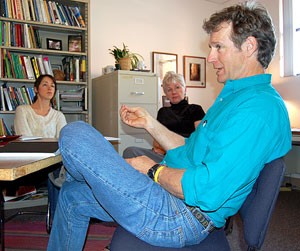English 101+ officially replaced English 100 in UA course offerings last semester. Students who place into English 100 at orientation are automatically enrolled in the 101+ class with the studio course, listed as English 197B.
Last semester, there were 498 students enrolled in 24 sections of 101+, each with two separate studio sections that divided each class in half. Graduate students, faculty and adjunct professors are eligible to teach this course.
The Wildcat sat down to discuss English 101+ with UA’s Anne-Marie Hall, director of the Writing Program; Erec Toso, a senior lecturer and faculty representative in the program; and Aja Y. Martinez and Kelly Myers, graduate assistants within the program.
Wildcat: When was the class first offered?
Toso: The class was first offered (in) fall 2003 as a pilot course. I think there were five sections.
W: And now it’s a full class?
Hall: We’ve eliminated English 100 altogether. And all students who need any help with developmental writing take English 101+. It’s 101 with a one-credit writing studio attached to it. … We’ve reduced the cost to the student and the time to degree by one full semester.
W: Is the one credit class taught by the same instructor?
Toso: The students get four credits, and it’s all taught by the same instructor. The one credit comes from a studio session, which is a smaller class. It’s 10 students instead of 20. In those sections, you really focus on the writing.
H: What the students need is not a whole other semester of writing. What the students need is more face time with the teacher. …There is a disproportionate number of minority students, athletes and first-generation college students that need developmental writing.
T: A preconception that some people bring to a course like this is that somehow the students are not as bright or not as creative. I’ll just go on record as saying that some of the brightest students I’ve had have been in courses like this.
Martinez: A lot of my work concerns how the inequality in the school systems, especially public school systems, doesn’t prepare the students, as well as more privileged students with more privileged backgrounds, that we get here. … These (former) students are more than capable … and doing things that further stigmatize and affect their confidence doesn’t necessarily help.
H: When you segment out an entire group of students by placing them into a separate course, 100, then they proceed through the sequence, off-sequence. Now they are being mainstreamed en masse this semester.
T: It’s a way to level the playing field while keeping them on track in terms of graduation rates.
W: Do you have statistics on the retention rates from the different pilots?
H: Yes, we do. This fall, about 500 students were in (English) 101+ compared to the 4,026 students in 101. … They are almost identical grades down the line. … The failure rate for 101 was 4.4 percent and for 101+ was 5 percent. The withdrawal rate for 101 was 1.5 percent, and it was 3.6 percent for 101+.
What’s significant about that is that those numbers are much lower than they would have been for 100 and that’s what’s important.
T: I used to teach at Tucson (Magnet) High. My classes there were probably 85 percent Hispanic, maybe 10 percent white, 5 percent Native American. I walked literally across the street to UA and taught first-year comp(position) here, and it was the reverse. It was 90 percent white and less than 10 percent Hispanic or Native American or black. So the UA is not recruiting the percentages of students in terms of diversity … and part of it has to do with in-egalitarian distribution of resources…
This course tries to include and incorporate a more diverse student population and to retain them and to help them succeed and to help them graduate on time.
W: Is the 101+ class offered only in the fall?
H: We are trying to do that. What we are trying to do is to get our courses on a fall/spring sequence. …However, there are summer outreach programs like New Start, so we’ll always have a few off-semester courses, but no longer will they only be made up of developmental writers.
Myers: I think that 101+ very explicitly tackles the confidence issues. And with the literacy narrative assignment right off the bat…we’re talking about what sort of held them back in terms of their readiness. They’re confronting these things, these ideas about themselves as writers that are really limiting. They are figuring out where that came from and how they can move past it.
T: There’s a line in a James Baldwin essay that says, “”We bumped against the ceiling of our possibilities.”” I think that’s a lot of what these students have been doing …and what we hope to do is raise that ceiling or remove it completely.
Martinez: It shifts the focus away from how it’s individually their fault or their problem, and the institution is taking on some of that responsibility.









